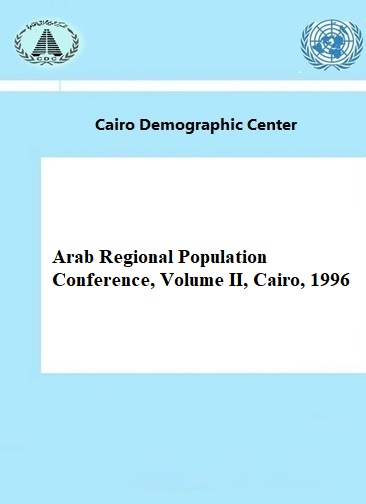S.9: Structural Adjustment, Poverty and Population Issues
S.9.1 Structural adjustment programs in Jordan: What are the likely demographic consequences?
By: Rebecca Miles Doan
S.9.2 Effects of structural adjustment programmes (saps) on population in some North African countries (Egypt, Tunisia, and Morocco).
By: Mahassen Mostafa Hassanin
S.10: Demographic Aspects of Education in the Arab World
S.10.1 Association between demographic circumstances and education from the perspective of educational planning in Arab Countries.
By: Abdelmegid M. Farrag
S.10.2 The demographic aspects of educational planning in the state of Kuwait (Arabic).
By: A.M. Abdelghany & Wessal Madou
S.10.3 Population education and reproductive health in teaching geography: content analysis empirical study (Arabic).
By: Taher Sallom
S.10.4 Reproductive behaviour's impact on education in the Syrian Arab Republic (Arabic).
By: Mousa El-Dareer
S.10.5 Future trends of population and education in nine Arab States.
By: Goujon & W. Lutz
S.11: Power and Authority Within the Family: Social and Demographic Correlates
S.11.1 Globalization and the struggle over the public sphere: negotiating power relationships in the family in a Low-income neighborhood in Cairo.
Farha Ghannam
S.11.2 Persistent patriarchies.
Suad Joseph
S.12: The Changing Economic Role of the Family
S.12.1Globalization, famille et entrepreneurship.
By: Riadh Zghal
S.12.2Famille et development socio-conomique, pour un nouveau contrat social.
By: Malika Ghefrane/Chraibi
S.12.3Groupes domestiques et parente en milieu rural Marocain: strategies economiques et enjeux sociaux.
By: Mokhtar El-Harras
S.13: Gender Inequalities and Social Development
S.13.1 The alliance between gender and kinship ideology: home-based female workers in Cairo's urban "informal sector".
By: Heba El-Kholy
S.13.2 Changing demographic behaviour in Morocco: The role of migration, family pattern, and women's status a comparison of the 1987 and 1992 DHS data.
By: Aurora Angeli & Silvana Salvini
S.13.3 Constructions of gender in middle and secondary school curriculum in Egypt.
By: Hind Wassef
S.14: What has Happened to Population Policies and Development Strategies in the Arab Region?
S.14.1 The Evolution of Population Policies in the Arab Region.
Mahmoud S. Issa
S.14.2 LA dimension Socio-economiqi dans les Politiques de Population et de Development dans la Region Arab.
By: Fatima-Zohra Oufriha
S.14.3 Fenese de la Politique de Population en Algere (1962-1979).
By: Ali Kouaouci
S.15: Determinants of Child Health Transition
S.15.1 Health Profiles of Children in Selected Arab Countries: An Investigation of Underlying Dynamics.
By: Eltigani E. Eltigani
S.15.2 Regional Inequality in Under-Five Mortality in the Arab World, 1960-1994.
By: Osman M. Galal & Azhar K. Qureshi
S.15.3 The dynamics of Gender Inequality: Trends in Gender-Specific Mortality among Children in Egypt, Jordan, and Tunisia, 1970-1990.
By: Kathryn M. Yount, Paul J. Rathouz & Kenneth Hill
S.15.4 GOBI-FF, strange names, and amulets: The Health and well Being of children in Upper Egypt.
By: Hania M. Sholkamy

